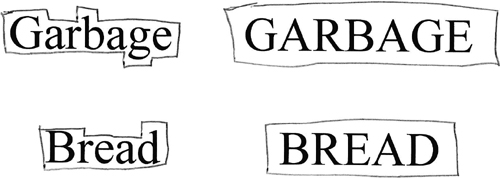44. It’s a Myth That Uppercase Letters are Inherently Hard to Read
You’ve probably heard that words in uppercase letters are harder to read than those in mixed case or lowercase. You’ve probably even heard some kind of percentage cited, such as “between 14 and 20 percent harder.” The story goes that we read by recognizing the shapes of words and groups of words. Words in mixed-case or lowercase letters have unique shapes. Words in uppercase letters have the same shape—a rectangle of a certain size—so, in theory, they’re harder to distinguish (Figure 44.1).
Figure 44.1. The word shape theory
This explanation sounds plausible, but it’s not really accurate. There’s no research showing that the shapes of words help us read more accurately or more quickly. A psycholinguist named James Cattell came up with that idea in 1886. There was some evidence for it then, but more recent work by Kenneth Paap (1984) and Keith Rayner (1998) has revealed that what we’re actually doing when we read is recognizing and anticipating letters. And then, based on the letters, we recognize the word.
So, is Uppercase Harder to Read?
We do actually read all-uppercase text more slowly, but only because we don’t see it as often. Most of what we read is in mixed case, so we’re used to it. If you practice reading text in all-uppercase letters, you’ll eventually read that text as fast as you read mixed case. This doesn’t mean you should start using uppercase letters for everything. Since people are unused to reading that way, it will slow them down. And these days, text in all uppercase is perceived as “shouting.” So feel free to use it—but use it sparingly.
![]() A good summary of the research on uppercase
A good summary of the research on uppercase
Kevin Larson wrote a great article summarizing the research on uppercase versus mixed case: http://www.microsoft.com/typography/ctfonts/wordrecognition.aspx

